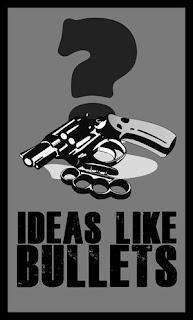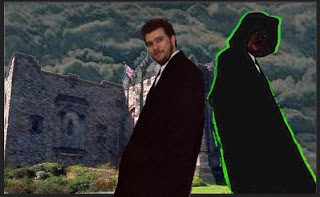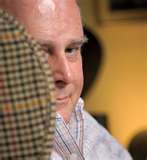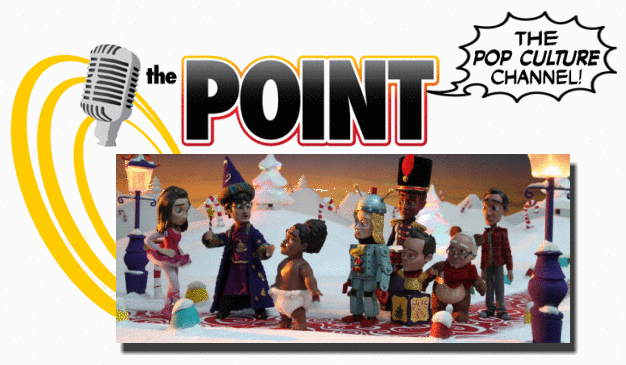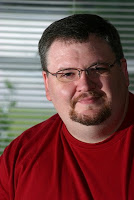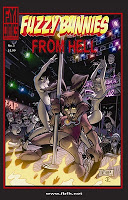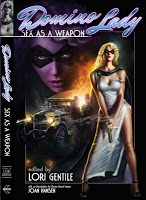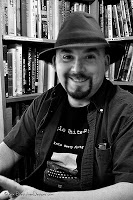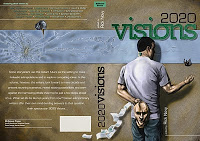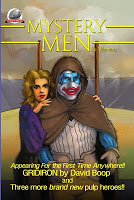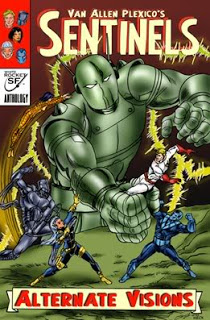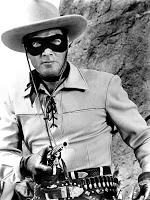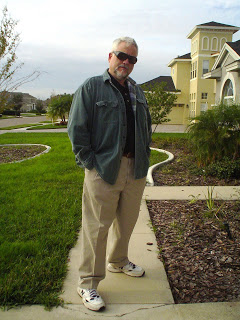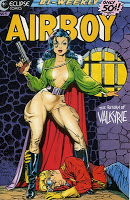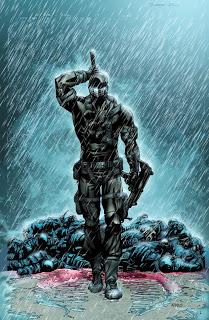BOBBY NASH-Writer, Columnist and member of ALL PULP’S SPECTACLED SEVEN!
AP: Bobby, thanks for putting away your convention travelin’ shoes and visiting with ALL PULP today. Tell us first, just who is Bobby Nash?
BN: Bobby Nash is a mystery wrapped in an enigma with a candy coated outer shell, a man who travels from town to town sharing tall tales with anyone who will listen. He– Oh, you wanted a serious answer. Well, in that case Bobby Nash is a writer of novels, comic books, novellas, short stories, graphic novels, and the occasional article, interview, column, and screenplay.
My official bio goes a little something like this:
From his secret lair in the wilds of Bethlehem, Georgia, Bobby Nash writes. A multitasker, Bobby’s certain that he does not suffer from ADD, but instead he… ooh, shiny. When he finally manages to put fingers to the keyboard, Bobby writes novels (Evil Ways, Fantastix), comic books (Fuzzy Bunnies From Hell, Demonslayer), short prose (A Fistful of Legends, Full Throttle Space Tales Vol. 2: Space Sirens), novellas (Lance Star: Sky Ranger, Ravenwood: Stepson of Mystery), graphic novels (Yin Yang, I Am Googol: The Great Invasion), and even a little pulp fiction (Domino Lady, Secret Agent X) just for good measure. Despite what his brother says, Bobby is not addicted to buying DVD box sets and can quit anytime he wants to. You can check out Bobby’s work at http://bobby-nash-news.blogspot.com, www.bobbynash.com, www.facebook.com/bobbyenash, www.twitter.com/bobbynash, and www.lance-star.com, among other places across the web.
AP: You’re a writer. When did you start writing and how did you end up writing in the pulp field?
BN: I started out writing comic book stories that I could draw because I wanted to be a comic book artist. Eventually, I realized that I would never make a living drawing comics, but I was told my stories showed promise. When I was in high school English class we used to get a list of words each week that we had to use in a sentence, but there was no challenge there so I asked the teacher if I could write a story and incorporate those words. He said fine and off I went. To challenge myself further I started writer cliffhangers and would have to use next week’s works to help get my characters out of whatever jam I’d gotten them into this week. I took these characters on grand adventures around the world. It was a lot of fun. One of the stories was published in a literary magazine so I guess that was my first pulp story.
Eventually I started writing comics for various publishers. I was having a ball with it, but one day I decided to write a sci fi novel, so I did. It needed a lot of work, but the story was told. I guess I was doing NA NO RI MO before I even knew what that was. Ha! Ha! I decided to try it again and started on a story that would eventually become Evil Ways, which turned out to be my first published novel.
Cut to a couple years later at Dragon Con in Atlanta and I’m set up in artist alley next to Ron Fortier, who I knew as a comic book writer. We talked writing a bit and he went home with a copy of Evil Ways, which he read and also reviewed on his Pulp Fiction Reviews site. When Ron started up what would become known as Airship 27 he invited me along to work on the anthology that became Lance Star: Sky Ranger. I had so much fun writing that one that I wrote Domino Lady, Secret Agent X, Ravenwood: Stepson of Mystery, and more Lance Star. The rest, as they say, is history.
AP: Can you give us a quick overview of what you’ve written?
BN: Sure. Here’s a list of my published works.
Novels: Evil Ways and Fantastix: Code Red.
Short story, novella, and anthology work: Lance Star: Sky Ranger Vol. 1 & Vol. 2 [Airship 27 Prod./Cornerstone Books], Startling Stories Magazine [Wild Cat Books], Sentinels Widescreen Special Edition [White Rocket Books], Full Throttle Space Tales Vol. 2: Space Sirens [Flying Pen Press], Sentinels: Alternate Visions [White Rocket Books], Domino Lady: Sex As A Weapon [Moonstone Books], Shadow One: Shades Of Gray [BEN Books], Real Magicalism [Daemon Press], and A Fistful of Legends [Express Westerns].
Comic books and graphic novels: Life In The Faster Lane, Fuzzy Bunnies From Hell [FYI Comics], Bubba The Redneck Werewolf [Brass Ball Comics], Demonslayer [Avatar Press], Threshold [Avatar Press], Doc Dresden: The Immortal [Odyssey Comics], Jungle Fantasy [Avatar Press], The Garden [Planetary Stories], Fantastix [FYI Comics], Yin Yang [Arcana Comics], and Lance Star: Sky Ranger [BEN Books].
AP: You’re closely associated with Lance Star, Sky Ranger. Who is Lance and what inspired you to create an aviator hero?
BN: Lance Star is a pulp-inspired aviator hero in the vein of G-8, Airboy, Captain Midnight, and Bill Barnes with just a little bit of Indiana Jones thrown in for good measure. Along with his Sky Rangers, Lance Star is a globetrotting adventurer. Whether they are fighting pirates off the coast of Hawaii, traveling to far off hidden mystical lands, running afoul of spies and saboteurs, or battling evil doers, the Sky Rangers are there.
Lance Star and the Sky Rangers were created as a group effort when the first anthology was being put together. Since I took ownership of the copyright I tweaked a few things, but the Sky Rangers remains heroic pulp characters much as they were in their first adventure in 2006.
AP: Pulp is a genre that wanes and waxes in popularity. What do you think is the reason for the current increase in popularity of Pulp today and how can writers and artists of new Pulp, such as yourself, make sure that Pulp becomes even more well known than it is and doesn’t see a downturn?
BN: Like everything, pulp will have its high and low points of popularity, but these things are cyclical so they will eventually come back around. All pulp creators can do is tell the best darn stories they can. Readers will find good stories.
AP: What about Pulp appeals to you as a writer?
BN: Pulp stories appeal to me because they are simple, fun adventures. I enjoy involved storytelling as much as the next guy, but sometimes I want a simple, fun, balls-to-the-wall adventure I can enjoy. I find pulp stories a joy to write.
AP: You’ve got a novel under your belt that might have some pulp overtones. What is EVIL WAYS about?
BN: Evil Ways is a mystery thriller novel. It is planned as a first in a series featuring FBI Agent Harold Palmer. I have already started a second novel titled Evil Intent. My plan is to complete the novel in 2011 and shop it around to publishers. The current publishing contract for Evil Ways ends in August of 2011 and I plan to (hopefully) rerelease it elsewhere as well.
Here’s the synopsis for Evil Ways:
A close call on the job sends FBI agent Harold Palmer on a non-voluntary vacation. At his wife’s insistence, Harold travels from Washington DC to Sommersville, Georgia where his brother, former Atlanta Journal Constitution investigative journalist Franklin Palmer, owns and operates the local newspaper. After a really intense story, Franklin called it quits and moved on to quieter surroundings, hoping to have put corruption and murder behind him.
Unfortunately, that kind of evil is not consigned only to major cities, as Franklin Palmer soon learns when another body is found inside Fort Greene State Park. He sees the timely arrival of his federal agent brother as his means to solve the case.
Also looking to recruit the help of the FBI agent is Sommersville Sheriff Tom Myers, who openly admits that he is out of his depth on the case. Multiple homicides are not something with which he has had much experience.
Reluctantly, Harold agrees to work with the two men to solve the case.
While the investigation proceeds, many visitors come home to Sommerville for the annual Autumn Festival as well as Sommersville High’s ten-year reunion. The town is abuzz with excitement.
Until the next victim is found.
As EVIL WAYS builds to its startling outcome, Harold, Franklin, and Sheriff Myers find themselves between a sadistic killer who feeds on the fear of his prey and the unsuspecting victims still on the killer’s hit list.
They should fear his evil ways.
One of the best reviews of Evil Ways said (paraphrasing) “Imagine if Die Hard’s John McClane found himself in a horror movie.” I love that and I use it all the time when telling people about the book.
AP: Writers often get into a story because of personal interests. What interests brought you to write EVIL WAYS?
BN: Not really. Evil Ways started out as a potential screenplay idea for a friend of mine who was wanting to shoot his first feature length movie. I came up with a story that utilized locations I knew we had access to and wrote for the actors available. When that didn’t happen I reworked and added to it for the novel. At the time I was doing that I did go to my ten year high school reunion and that gave me the reason to have all of the characters coming back to town in the story. My reunion wasn’t necessarily as exciting as the one in the novel, but at least we all survived it. Ha! Ha!
The two main protagonists, Harold and Franklin Palmer are brothers. I was talking a writing class at the time I wrote Evil Ways and I read some pages with the brothers and several of the others told me that they didn’t “feel” like brothers. I worked at it, but something was missing. Finally, I decided to give one of the brothers my personality and the other my brothers and then wrote how we interact. Suddenly, people could tell they were brothers without me telling them. I learned a lot about casting my characters that day.
AP: Your main character is a FBI agent pulled into this suspense thriller. Was there any inspiration for Harold Palmer or is this a case of the writer writing himself into the tale?
BN: I don’t recall any specific reason for making Harold an FBI agent other than I thought it would make for a nice dynamic between him and the local sheriff when they meet and find themselves working together to stop a killer. As I mentioned before, the part of Harold that is “me” is his personality when it comes to interacting with his brother. A secondary concern that came near the end of writing the novel was an idea for a second novel featuring Harold Palmer. That caused me to add a few tweaks to his job with the FBI and also led to the opening chapter being added to set up book two. The first thing you read in Evil Ways was actually the last thing I wrote for it.
AP: You have a background in comics as well, including the Lance Star ONE SHOT. What other comics have you worked on. Any you would consider pulp comics or at least having pulp influences or connections?
BN: Comics were my first love. I started reading them when I was a kid after discovering the 60’s Spider-man cartoon in syndication, but really got into them in my teenage years. The first comics I remember owning came in a 3-pack. Amazing Spider-man 192, 193, and 194. I still have them to this day. We moved when I was twelve and the first new friends I made at my new school were comic fans and they were also big into creating their own comics. After that I was hooked.
I’ve bounced around with some local productions and even published a fanzine for a few years called Odyssey Magazine. My first professional comic writing gig was on Marat Mychaels’ Demonslayer, published by Avatar Press. I also worked on Threshold and Jungle Fantasy for Avatar. For 12 years I wrote and drew Life In The Faster Lane for Keeping Up With Kids Magazine, which was a lot of fun. I also wrote Fuzzy Bunnies From Hell, Bubba The Redneck Werewolf (a back up story), Doc Dresden: The Immortal, Fantastix, Yin Yang, Lance Star: Sky Ranger, and The Garden (for Planetary Stories online magazine). Coming up I have I Am Googol: The Great Invasion, more Lance star: Sky Ranger, and a few projects I can’t talk about quite yet.
AP: Expanding on the last question, many fans and creators agree that pulps gave birth to a lot of ideas we now see in comic books. Are pulps still a viable source of comic inspiration or are the two more or less influencing/encouraging one another now idea wise?
BN: Sure. I think there are comic book characters that fit the definition of pulp. I also think there are pulp characters that will translate well into comics. I’m actually working on a comic book anthology featuring pulp characters and it was interesting to see these characters in that format.
AP: You are known for attending conventions seemingly year round. How many conventions did you attend this year?
BN: As of today, I have been a guest at 15 conventions this year. This coming weekend I’ll be at the first Wizard World Atlanta Comic Con and there is a 1 day show in Charlotte, NC in December I may attend. That would bring my total to 16 or 17 for the year.
AP: What is the draw for you to attend conventions? Is it more than just selling product?
BN: Absolutely. I have a lot of fun at conventions whether they are money makers or not. Obviously, I would prefer to cover my costs and bring a little extra home, but that doesn’t always happen. Sometimes it does. Not only are the cons a great ways to meet your fans and promote and sell your books, but it’s also a great place to meet new people and visit new places you’ve never been before. Plus, it gets me out of the house. I love ‘em. I’d do more if I could afford it.
AP: What about the future? What do you have in the works that might appeal to the ALL PULP audience?
BN: There are plans for some upcoming pulpy stuff from me. I recently turned in my story for Lance Star: Sky Ranger anthology vol. 3, which will be out sometime in 2011. I’m about halfway on a lance Star: Sky Ranger novel titled “Cold Snap” for next year as well. The Ravenwood: Stepson of Mystery anthology should be out in either December or January and features a story by me. Other anthologies in the works are Secret Agent X, The Wraith, Mars McCoy: Space Ranger, and a few other surprises. The aforementioned are from Airship 27 and Cornerstone Books. I’ve also written a Green Hornet tale for Moonstone and have turned in stories for Aym Geronimo and the post Modern Pioneers: Tall Tales and Tales From The Zero Hour: Weird Tales. I’m also planning more Lance Star: Sky Ranger comic books as well. I’m also shopping around and writing more novels. Plus, a few hush-hush items I’ll have to tell you about later.
2011 looks to be a busy year for me.
AP: Bobby, ALL PULP appreciates you stopping by! See ya on the road!
BN: My pleasure.


